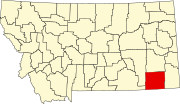
Powder River County is a county in the U.S. state of Montana. As of the 2020 census, the population was 1,694. Its county seat is Broadus.

Mandan is a city on the eastern border of Morton County and the eighth-most populous city in North Dakota. Founded in 1879 on the west side of the upper Missouri River, it was designated in 1881 as the county seat of Morton County. The population was 24,206 at the 2020 census. Across the Missouri River from Bismarck, Mandan is a core city of the Bismarck–Mandan Metropolitan Statistical Area.

The Tongue River is a tributary of the Yellowstone River, approximately 265 mi (426 km) long, in the U.S. states of Wyoming and Montana. The Tongue rises in Wyoming in the Big Horn Mountains, flows generally northeast through northern Wyoming and southeastern Montana, and empties into the Yellowstone River at Miles City, Montana. Most of the course of the river is through the beautiful and varied landscapes of eastern Montana, including the Tongue River Canyon, the Tongue River breaks, the pine hills of southern Montana, and the buttes and grasslands that were formerly the home of vast migratory herds of American bison.
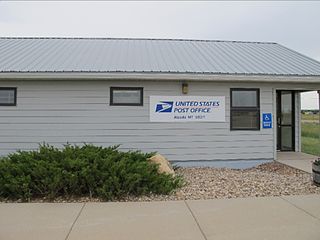
Alzada is a census-designated place in southern Carter County, Montana, United States. As of the 2010 census it had a population of 29. It is located at the intersection of U.S. Route 212 with Montana Secondary Highways 323 and 326, near the Wyoming and South Dakota borders. The Little Missouri River flows northwards to the west of the community. Alzada is in the Mountain Time Zone.

Spotted Tail was a Sichangu Lakota tribal chief. Famed as a great warrior since his youth, warring on Ute, Pawnee and Absaroke (“Crow”), and having taken a leading part in the Grattan Massacre, he led his warriors in the Colorado and Platte River uprising after the massacre perpetrated by John M. Chivington's Colorado Volunteers on the peaceful Cheyenne and Arapaho camping on Sand Creek, but declined to participate in Red Cloud's War.

Fort Keogh is a former United States Army post located at the western edge of modern Miles City, in the U.S. state of Montana. It is situated on the south bank of the Yellowstone River, at the mouth of the Tongue River.
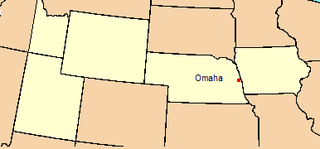
The Department of the Platte was a military administrative district established by the U.S. Army on March 5, 1866, with boundaries encompassing Iowa, Nebraska, Dakota Territory, Utah Territory and a small portion of Idaho. With headquarters in Omaha, the district commander oversaw the army's role initially along the Overland route to Salt Lake City, then later the construction route of the Union Pacific Railroad. The district also included the Montana road through eastern Wyoming. The district was discontinued when the Army's command was reorganized in 1898.
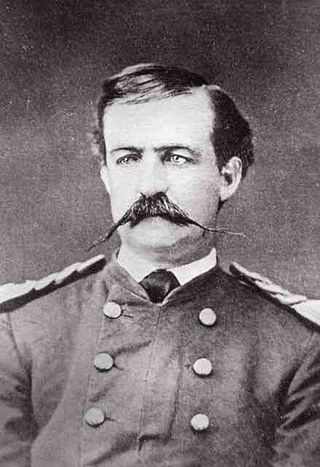
Gustavus Cheyney Doane was a U.S. Army Cavalry Captain, explorer, inventor and Civil War soldier who played a prominent role in the exploration of Yellowstone as a member of the Washburn–Langford–Doane Expedition. Doane was a participant in the Marias Massacre of approximately 200 Piegan Blackfeet people.

The Northern Cheyenne Exodus, also known as Dull Knife's Raid, the Cheyenne War, or the Cheyenne Campaign, was the attempt of the Northern Cheyenne to return to the north, after being placed on the Southern Cheyenne reservation in the Indian Territory, and the United States Army operations to stop them. The period lasted from 1878 to 1879.

Camp Poplar River was established during the Indian wars in the Department of Dakota by U.S. Army to maintain order, keep non-agency Indians away, and help capture the Indians who disturbed the peace and would not conform to reservation boundaries of the Fort Peck Agency, which in 1878, was relocated to its present-day location in Poplar because the original agency was located on a flood plain, suffering floods each spring. The post was located one-half mile north of the then called, Poplar River Agency, or 2 miles north of the Missouri River on the south bank of the Poplar River and normally consisted of only two companies of infantry. This tiny post has disappeared except for the fact that the town of Poplar, Montana, on the site, bears the same name.

Fort McKinney (1877–1894) was a military post located in North Eastern Wyoming, near the Powder River.

The Powder River Crossing, officially known as Powder River Station-Powder River Crossing , is an abandoned settlement located on the east bank of the Powder River in southeast Johnson County about twenty-four miles east of Kaycee, Wyoming. It developed after a wooden toll bridge was built across the Powder River in 1877, at a site that was originally used as a ford. With crossing secured, a settlement developed here in the late 19th century, incorporating a stage stop on the Bozeman Trail. The site is notable for having well-preserved wagon ruts from the pioneer era.
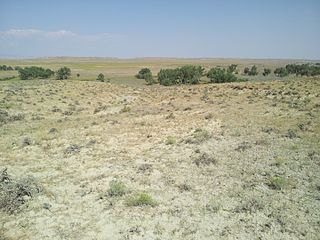
Crazy Woman Crossing is a historic place on the Bozeman Trail, in Johnson County, Wyoming, United States, about twenty miles southeast of Buffalo. Crazy Woman Crossing was one of three major fords used by travelers across creeks and rivers in this area. It is significant as the site of the Battle of Crazy Woman, a skirmish during Red Cloud's War in 1866. The United States pulled out of this territory after negotiation with the Lakota and allies of the Treaty of Fort Laramie of 1868.
The Battle of Platte Bridge, also called the Battle of Platte Bridge Station, on July 26, 1865, was the culmination of a summer offensive by the Lakota Sioux and Cheyenne Indians against the United States army. In May and June the Indians raided army outposts and stagecoach stations over a wide swath of Wyoming and Montana. In July, they assembled a large army, estimated by Cheyenne warrior George Bent to number 3,000 warriors, and descended upon Platte Bridge. The bridge, across the North Platte River near present-day Casper, Wyoming, was guarded by 120 soldiers. In an engagement near the bridge, and another against a wagon train guarded by 28 soldiers a few miles away, the Indians killed 29 soldiers while also suffering at least eight dead.
Rochford is an unincorporated community in Pennington County, South Dakota, United States. It is not tracked by the U.S. Census Bureau.
The Battle of Pumpkin Creek, also known as the Volborg fight, was fought February 7–8, 1880, by United States Soldiers, and Scouts, against Sioux warriors. The Battle occurred near Pumpkin Creek, a tributary of Tongue River, in Montana Territory, in present-day Montana, United States.
Camp Devin was a temporary United States Army camp established on June 30, 1878 during the building of the Fort Keogh-Deadwood Telegraph Line. It was named for Brevet Major General Thomas C. Devin, and abandoned in late 1878.
Fort Maginnis was established during the Indian wars in the Department of Dakota by the U.S. Army. It was the last of five forts: Keogh (1876), Custer (1877), Missoula (1877), Assinniboine (1879), and Maginnis (1880) - built following the defeat of Lieutenant Colonel George A. Custer by Native Americans at the Battle of Little Bighorn in June, 1876.
The Powder River Battles were a series of battles and skirmishes fought between September 1–15, 1865 by United States soldiers and civilians against Sioux, Cheyenne, and Arapaho warriors. The fighting occurred along the Powder River in Montana Territory and Dakota Territory, in present-day Custer and Powder River counties, Montana and northeastern Wyoming.














